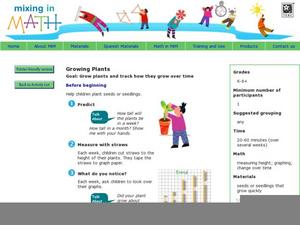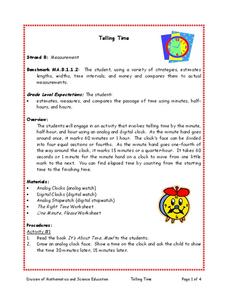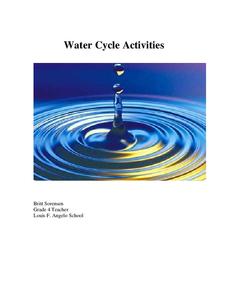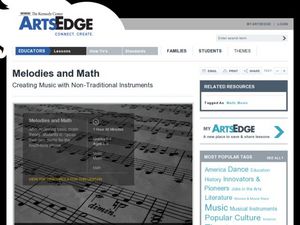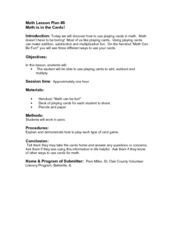Curated OER
Telling Time
Students identify numerals on a clock and put them in correct order. They identify the hour and minute hands on a clock. Students practice time skills by telling time by the hour using a standard clock.
Curated OER
Telling Time to 5 Minutes
Students take part in various activities ranging from creating a human clock, to small group problem solving to reinforce the concept of telling time accurately to five minutes on an analog clock.
Mixing In Math
Mixing in Math: Growing Plants
Whether you have your class plant seeds or begin when sprouts are visible, math skills are used here to predict and track growth over time. Straw bar graphs show plant height on a given day while the graph as a whole shows changes over...
Curated OER
Clocks and Time
Second graders observe and demonstrate how to tell and write time. They discuss different ways and things that tell time, then listen to a teacher-led lecture about the hands on a clock. Students complete a worksheet along with the...
Curated OER
Telling Time
Young scholars estimate, measure, and compare the passage of time using minutes, half hours, and hours. They read the book 'It's About Time, Max!' with the teacher and draw an analog clock face. They show the time and 30 minutes later,...
Curated OER
Time
Students review the concept of the hour. In this time lesson, students understand how the hour hand works. Students have another clock which also shows the minute hand. Students recognize the position of the minute hand.
Curated OER
1, 2, 3 o' Clock Rock
Second graders identify the hour and minute hands. They tell time by the hour, nearest quarter hour, half hour, and determine the relationships of time (e.g. minutes in hour, days in a month, weeks in a year). They create over-sized...
Curated OER
Math Throughout the Day
Learners practice their number sense throughout the day. They practice their use and understanding of numbers in every part of the day. Students watch and listen to the teacher count students in class, sort themselves based on colors or...
Curated OER
Math Quilts
Students examine geometric quilt patterns to identify how math may have been used to help slaves escape to freedom. They slide, flip and turn geometric shapes to create a map quilt.
Curated OER
Water Cycle Activities
Explore the water cycle in all aspects with a resource packed full of activities and lessons. The 37-page packet comes with vocabulary, a game, writing prompts, printables, and opportunities to journey through the stages in the water...
Curated OER
Telling the Time
Students practice telling time by completing the various activities. In this telling time activity, students view a large clock and discuss the words 'to' and 'past' the hour. Students count in 5s using the clock and then set their own...
Curated OER
Telling Time
Students practice telling time using five and ten minutes intervals. They use their arms and bodies to show the time while following teacher led instructions. They go through the motions as a whole class.
Curated OER
Random Times
In this telling time worksheet, students read the digital times for each example and draw the hands on the clock to show the time 15 minutes later. Students complete 15 problems.
Curated OER
Time & Itineraries Two
Students explore time management by participating in itinerary activities. In this time telling lesson, students identify how to read a clock, how to communicate the time to others and how to plan for events in the day. Students practice...
Curated OER
What time is it, Mr. Clock?
Students practice telling time through movement, teamwork and cooperation - as they demonstrate how a clock represents time. They play a game of telling time in order to master the lesson objectives.
Curated OER
Basic Units of Time
Students review fundamental concepts of time such as A.M. and P.M. and learn about elapsed time. In this Unit of Time lesson, students review the basics of how to tell time and then are given examples to figure out how much time has...
Curated OER
What Time Is It?
Fourth graders distinguish between analog and digital clocks and read time from both types. In this clock reading lesson, 4th graders discuss the types of clocks and the time zones. Students find times in specific time zones. Students...
Curated OER
Sun and Shadows
Why do shadows look different in the summer than in the winter? What causes day and night? How can a sundial be used to tell time? Answer these questions and more through two engaging lessons about light and shadows. Fourth and fifth...
Curated OER
Just a Minute!
Students put the standard measure of clock time -- the minute -- in perspective. This lesson can be modified for virtually any grade level. They write about what they learned about a minute as a result of the activities.
Curated OER
It's About Time!
Students read a short tutorial and complete one or more online activities. They visit an online math dictionary to learn the value of a day, month, week, and year. In addition, they construct word problems based on a favorite month;...
Curated OER
Time: Attribute
Students participate in five teacher-led, whole class activities that explore sequences of time and the concept of faster and slower. They sequence school day events, create a book of their daily schedule, put the days of the week in...
Curated OER
Melodies and Math: Creating Music with Non-Traditional Instruments
Review the 4/4 and 2/4 time signatures in music with a helpful music theory lesson plan. Young musicians experiment with electronic sounds and create their own musical performance using instruments made from materials found in the...
Curated OER
Math is in the Cards!
Is the rainy day schedule disrupting your class? Here is a great way to practice basic addition, subtraction, and multiplication skills while building automaticity and problem solving. This activity provides the rules to three different...
Bowland
Outbreak: Infection Detection
Explore the mathematics of infection outbreaks with activities that ask learners to use coordinate grids to locate infected patients. They calculate amounts of ingredients for antidotes and determine which groups of people should be...




